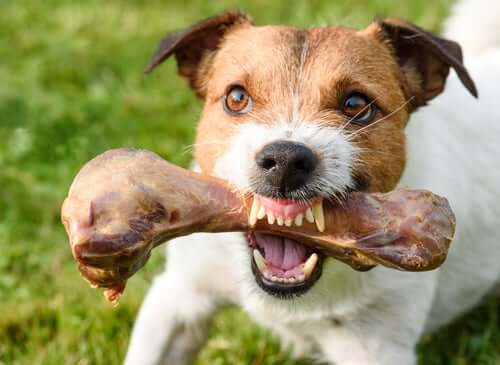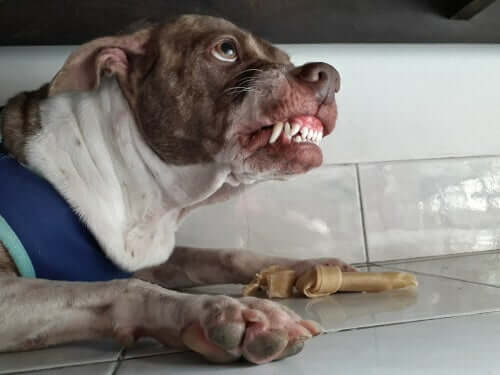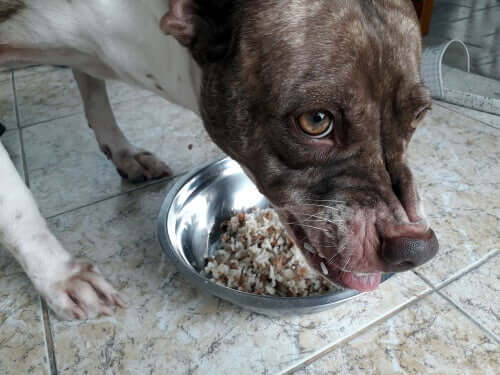What is Food-Related Aggression in Dogs?

When dogs become aggressive in order to protect their food, this can become a serious problem. In this situation, there’s a danger that other dogs or humans can end up getting bitten. What’s more, this problem of food-related aggression can get worse over time as dogs can end up becoming possessive.
It’s normal for dogs to behave protectively when it comes to their possessions. Wild animals that protect their valuable resources, such as food, mates, and territories, have a better chance of surviving in nature.
The tendency to protect food and other valuable articles is not a desirable behavior when it comes to domestic pets.
How to recognize food-related aggression?
Food-related aggression is a way in which dogs protect their resources. It’s when some dogs become very defensive when eating, and they use threats in order to force others to keep their distance.
Dogs may direct this type of aggression towards other animals, human beings, or both. If a dog barely growls or shows its teeth, then the aggression is considered mild. Moderate aggression refers to dogs that pounce when someone approaches. In the most serious cases, dogs will bite those they see as a threat.

What’s the origin of food-related aggression?
It’s easy to assume that food-related aggression is a demonstration of dominance, but that’s not always the case. Competing for food with other members of the pack is the main cause behind this behavior.
Often, there may be one or two puppies that dominate the food bowl at mealtime and use aggression to achieve this. Any puppy that exhibits protective behavior around food before the age of 16 weeks should be seen by a veterinarian. This is an early sign of aggressive behavior development.
There are a variety of things that dogs consider valuable
Although many dogs only hoard food, other dogs become possessive of chew bones and toys as well. Some hoard objects they’ve stolen, live dry food packaging they’ve fished from the trash, socks, etc.
In some cases, dogs will only become protective of their resources around particular people–usually strangers. In other cases, dogs protect their possessions from all humans.
How to recognize if aggression is food-related
First of all, observe the body language of your canine while it’s eating. You may notice the animal’s body becomes more rigid and that its head remains low, close to the food .
What’s more, other signs are that the whites of your dog’s eyes may be visible. It may keep its ears back, its tail down, and its fur may stand up. Dogs may show any or all of these signs. Finally, on top of the signs we just mentioned, dogs may also growl, pounce, or bite.

Is it possible to control a dog’s food-related aggression?
The first step involves evaluating your dog’s overall behavior. Is your dog only possessive of food? Or does the aggressive behavior extend to other things like favorite toys, rest areas, and even other members of the pack?
If your dog’s behavior is not limited to food alone, then the animal is displaying general protection of resources. It’s very important to understand this situation and understand your dog’s motives.
Evaluate the confidence and overall behavior of your dog
If your dog is naturally dominant, then you should reaffirm yourself as the pack leader in a calm and assertive way. At the same time, if your dog is shy or fearful, you will need to build up its confidence. What’s more, teach your pet that its food is safe even when human beings are around.
Finally, it’s important to determine if a dog’s food-related aggression is mild, moderate or severe. In cases of severe aggression, start out by consulting with a professional in order to carry out the right course treatment.
Simple techniques for beginning to change aggressive behavior in dogs
Establish meal times. Some dogs are aggressive about food because they don’t know when the next time they get food will be. If that’s the case, then being consistent about meal times will be a big help. Make sure to stick to your routine every day.
Dogs have a very good internal clock. Therefore, it’s quite easy for them to learn when it’s time to wake up, take a walk, expect owners to come home, etc. Punctuality regarding meal times will help reduce your pet’s anxiety .
All cited sources were thoroughly reviewed by our team to ensure their quality, reliability, currency, and validity. The bibliography of this article was considered reliable and of academic or scientific accuracy.
- Snitcofsky, M. (2017).Desarrollo comportamental y crianza adecuada en caninos. eukanuba.com.ar
- Fernández Foruny, A. (2008). Agresividad por dominancia. ETCAN. Etología Canina. Voraus.com El Perro de Utilidad y de Deporte.
